There are 21 species of turtles in Maryland, which range from groups such as Box turtles, Musk turtles, and mud turtles, to larger species like Snapping turtles. Some of these species, such as the Bog turtle, are threatened.
3 other species have recently been introduced. These are the False Map turtle, the Red-eared Slider and the Yellow-bellied Slider. This is usually due to formerly captive specimens being released or escaping into the wild.
There are also 5 species of sea turtles that are native to the waters of Maryland, varying between the Leatherback, Loggerhead, Ridley, Hawksbills, and Green sea turtles. All of these are unfortunately endangered species. Here is our guide to the native turtles in Maryland.
Turtles in Maryland
1. Bog Turtle

- Experience Level: Beginner
- Family: Emydidae
- Scientific Name: Glyptemys Muhlenbergii
- Adult Size: Between 3 ½ to 5 inches
- Lifespan: Up to 40 years
- Average price range: Between $250 and $450
Bog turtles are the smallest turtle species in North America and mainly found in open areas in Maryland’s central northern counties. Unfortunately, they are a critically endangered species.
Also known as Muhlenberg’s turtle, Bog turtles have keeled shells that range from olive or dark brown to black. Some of the scutes may have yellow or red star-like patterning.
Bog turtles are omnivores and will mainly eat earthworms, mollusks, and invertebrates along with occasional pieces of vegetation. They are active during the warmest parts of the day and can eat on land or in the water.
2. Diamondback Terrapin
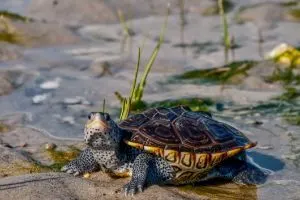
- Experience Level: Beginner to Intermediate
- Family: Emydidae
- Scientific Name: Malaclemys Terrapin
- Adult Size: 4 ½ to 5 ½ inches (Males) and 6 to 9 inches (Females)
- Lifespan: Between 25 and 40 years
- Average price range: Between $250 to $300
- Recommended books: Map Turtles and Diamondback Terrapins by W.P. Mara
These aquatic terrapins favor the marshes and coastal or estuary shorelines of Southern Maryland, especially during the breeding season. They can often be seen swimming in the water with their heads poking out, similar to periscopes.
Diamond-backed terrapins have wedge-shaped shells that range between brown or gray to yellow and even black. Their scutes sport concentric rings, and also central keel ridges running down the spine of the carapace.
These terrapins feed on crustaceans, mollusks, and other invertebrates as well as shellfish such as clams or winkles. They will also occasionally eat vegetation.
Check out our article on Diamondback Terrapins to learn more.
3. Eastern Box Turtle
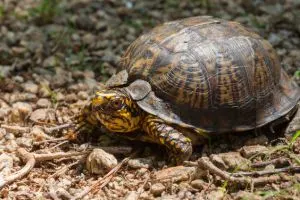
- Experience Level: Beginner
- Family: Emydidae
- Scientific Name: Terrapene Carolina Carolina
- Adult Size: Between 4 and 7 inches
- Lifespan: Up to 40 years
- Average price range: Between $120 and $400
- Recommended books: Box Turtles: Complete Herp Care by Tess Cook
Eastern Box turtles are a common species native to Maryland. Their high domed dark brown shells sport distinctive yellow and orange markings. Their plastrons are also dark brown. Uniquely, Eastern Box turtles can regenerate their shells.
These terrestrial turtles can roam up to 50 meters a day in search of food. Eastern Box turtles are omnivores will eat fish and invertebrates as well as plants.
Eastern Box turtles prefer woodland as well as marshy and grassland areas. They have a home territory of around 230 meters and live near streams and ponds.
4. Eastern Mud Turtle
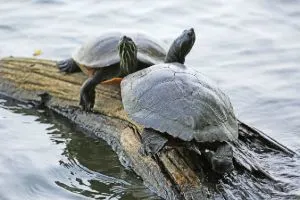
- Experience Level: Beginner
- Family: Kinosternidae
- Scientific Name: Kinosternon subrubrum
- Adult Size: Between 3 and 5 inches
- Lifespan: Up to 50 years
- Average price range: $40 to $100
Eastern Mud turtles can mainly be found on Maryland’s coastal plains. They like shallow, slow-moving waters, especially swamps, tidal marshes, or bogs. They tend to move around on land a fair amount, not always staying near the water.
These turtles have smooth, oval shaped carapaces that range between brown and yellowish in color. Their shells drop quite sharply at the sides and back, whilst their plastrons are larger than those of their Musk turtle relatives.
Eastern Mud turtles are omnivorous and mainly eat worms, snails and other mollusks and sometimes fish. They will also eat plants.
5. Striped Mud Turtle

- Experience Level: Beginner
- Family: Kinosternidae
- Scientific Name: Kinosternon Baurii
- Adult Size: Between 4 and 5 inches
- Lifespan: Up to 50 years
- Average price range: Between $75 and $160
Easily identified by the three light stripes visible on their dark brown shells, Striped Mud turtles also have yellowish stripes running between their eyes and nostrils. Often their markings can be seen when wet.
Striped Mud turtles are relatively recent discoveries in Maryland, seen in only a couple of counties so far. They have been seen in creeks and rivers near forested floodplain areas.
These turtles are omnivores, mainly feasting on mollusks, worms, invertebrates, and fish as well as occasionally eating plants and algae. They tend to move around on land a fair amount as well.
6. Common Musk Turtle
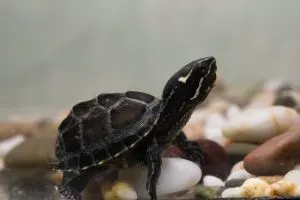
- Experience Level: Intermediate
- Family: Kinosternidae
- Scientific Name: Sternotherus Odoratus
- Adult Size: Between 4 and 5 inches
- Lifespan: 50 years and over
- Average price range: Between $20 and $90
- Where to buy: theturtlesource.com, undergroundreptiles.com
Also known as “Stinkpots” due to the strong smell they can release from their musk glands, Eastern Musk turtles use this ability to protect themselves from predators. They are common throughout Maryland.
Eastern Musk turtles have dark, unmarked shells. Their heads are also dark, with yellow lines along their faces. They prefer permanent bodies of water as well as marshy areas.
An omnivorous species, Eastern Musk turtles hunt for prey by scent. They mainly eat mollusks, crayfish, small fish, and tadpoles. They aren’t strong swimmers, so do not really chase prey.
7. Northern Map Turtle

- Experience Level: Beginner
- Family: Emydidae
- Scientific Name: Graptemys Geographica
- Other Name: Common map turtle
- Adult Size: Between 4 and 10 ½ inches
- Lifespan: 15 to 20 years
- Average price range: Between $20 and $60
- Where to buy: turtlestore.com
Common Map turtles have dark brown or olive green shells, and are named for their markings, which resemble the contours of a map and are often yellow in color. Small yellow spots behind the eyes separate the Common Map turtle from other subspecies.
Common Map turtles are endangered in Maryland, mainly confined to northern counties around the Susquehanna River. They are a mainly aquatic species and rarely venture far from the water. They do like to bask and are great swimmers.
These turtles are mainly carnivorous, feeding on fish and aquatic invertebrates like crayfish, but also occasionally eat plant.
8. Northern Red-Bellied Cooter

- Experience Level: Beginner to Intermediate
- Family: Emydidae
- Scientific Name: Pseudemys rubriventris
- Adult Size: Between 8 and 12 ½ inches
- Lifespan: Between 40 and 55 years
- Average price range: Between $30 and $170
- Recommended books: Aquatic Turtles: Sliders, Cooters, Painted, and Map Turtles by R.D. Bartlett
Northern Red-bellied Cooters are North America’s largest pond turtles. They are regular baskers, but can be cautious and shy. They mainly inhabit rivers and ponds with soft bottoms and occasionally brackish water, and are common to much of Maryland.
Named and identified by their eponymous red colored plastrons, Northern Red-bellied Cooters also have reddish lines on some of their scutes. Shells range from olive green to black. They also have yellowish markings on their skin.
These turtles are omnivorous, mainly feeding on mollusks and invertebrates. Adult Northern Red-bellied Cooters may eat far more vegetation than juveniles.
9. Painted Turtles
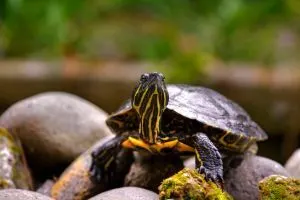
- Experience Level: Beginner
- Family: Emydidae
- Scientific Name: Chrysemys Picta
- Adult Size: Between 4 and 10 inches
- Lifespan: Between 30 and 50 years
- Average price range: Between $20 and $50
- Recommended books: Painted Turtle Pet Owners Guide by Ben Team
The Eastern Painted and the Midland Painted are two Painted turtle subspecies native throughout Maryland. A popular species of turtle to keep as a pet, Painted turtles have dark shells with faint yellow stripe markings.
Eastern Painted turtles have plastrons ranging from red to orange, with black and yellow patterning. Midland Painted turtles can be distinguished by a dark, shadow-like patch in the center of their plastrons.
Mainly an aquatic species, Painted turtles stay near the water and like to bask. Painted turtles are omnivorous and mainly eat mollusks, frogs, and underwater invertebrates. They must swallow food in the water.
10. Common Snapping Turtle
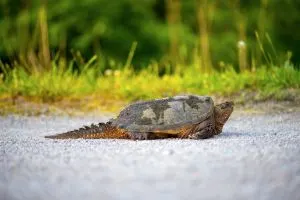
- Experience Level: Intermediate to Expert
- Family: Chelydridae
- Scientific Name: Chelydra Serpentina
- Adult Size: Between 8 and 20 inches
- Lifespan: Between 30 and 50 years
- Average price range: Between $20 and $40
- Recommended books: Snapping Turtle Pet Owners Guide by Ben Team
The largest freshwater turtles native to Maryland, Common Snappers are found in virtually any body of water across the state. They can be aggressive and will often hiss and bite. They do not bask often, preferring to remain in the water.
Identified by their distinctive hooked “beaks”, Common Snappers usually have dark brown or green shells. They also have relatively strong claws and long tails that sport saw-toothed ridges.
Common Snappers are nocturnal omnivores, mainly eating fish and other aquatic prey. They also consume underwater vegetation. There have been some instances of Snappers eating small waterbirds if they get close enough.
11. Spiny Softshell Turtle
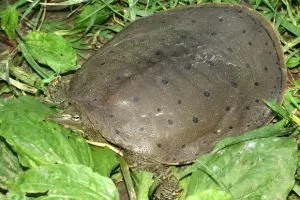
- Experience Level: Intermediate to Expert
- Family: Trionychidae
- Scientific Name: Apalone Spinifera
- Adult Size: 5 to 9 ½ inches for males, 7 to 17 inches for females
- Lifespan: Between 20 and 50 years
- Average price range: Between $70 and $280
- Recommended books: Softshell Turtle Owners Guide by Ben Team
Spiny Softshell turtles have a pancake-like shell and sport several dark circles. They feel like sandpaper to the touch. These turtles will scratch and bite if handled or caught. They have long, tubular beaks.
Spiny Softshells are currently only found in Garrett County in the west of Maryland. They require a sandy habitat for burrowing and egg laying. They sleep buried in the sand, and are active during the day.
These turtles are fast swimmers. They are carnivores and will feed on any crustaceans, invertebrates, and mollusks they can find. They also occasionally eat aquatic plants.
12. Spotted Turtle
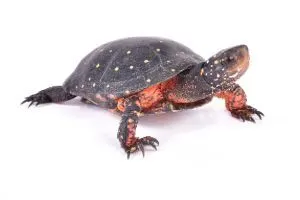
- Experience Level: Intermediate to Expert
- Family: Emydidae
- Scientific Name: Clemmys Guttata
- Adult Size: Between 4 and 5 inches
- Lifespan: Between 25 and 50 years
- Average price range: Between $75 and $100
Spotted turtles are a small, beautiful species. Their smooth shells are black, covered with their eponymous bright yellow dots. Their plastrons are yellow with large black patches of varying sizes on either side.
These semi-aquatic turtles prefer shallower waters alongside wetland and marshy habitats. Spotted turtles like to bask, often perching themselves on logs by the water. They prefer areas with soft ground and can wander away from water.
This omnivorous species often eats invertebrates, crustaceans, mollusks as well as vegetation. Their small size makes them great pets. They are a common species throughout Maryland.
13. Wood Turtle

- Experience Level: Intermediate
- Family: Emydidae
- Scientific Name: Glyptemys Insculpta
- Adult Size: Between 5 ½ to 8 inches
- Lifespan: 40 years in the wild, 58 years in captivity
- Average price range: Between $249 and $495
- Recommended books: Wood Turtles: A Pet Care Guide for Wood Turtles by Lolly Brown
Wood turtles are an intelligent species mainly found in western counties of Maryland. Their main habitats are woodlands and ponds.
They are active during the day and roam widely while looking for food. They are omnivores and often eat berries, plants, mollusks and earthworms. They can rock themselves to create vibrations in the soil, fooling worms into thinking it’s raining.
Wood turtles are so named for their shells, which are rough and feel like wood. Their patterning looks similar to growth rings and wood grain. They are mostly brown in color, with pyramid-shaped scutes.
In recent years, 3 other, non-native species of turtles have been spotted in Maryland. These specimens are usually former pet turtles that have been released into the wild.
Currently, these introduced species are the False Map turtle, the Red-eared Slider and the Yellow-bellied Slider. Any sightings of these turtles in Maryland should be reported.
14. False Map Turtle
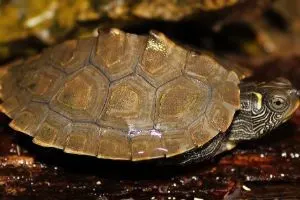
- Experience Level: Beginner
- Family: Emydidae
- Scientific Name: Graptemys pseudogeographica
- Adult Size: Between 3 ½ and 10 ½ inches
- Lifespan: Between 30 and 50 years
- Average price range: Between $6 and $40
False Map turtles are not native to Maryland but have been spotted the northern Frederick County. They rarely travel far from the water, and like to bask on outcrops over the water surface.
False Map turtles have dark shells, often brown or black and have contour-like yellow markings. As the turtle ages, this pattern gets fainter. Most adults have a pronounced keel on their backs.
To distinguish from other Map turtles, False turtles lack colored patches and markings on their heads. This species is omnivorous and eats aquatic invertebrates, crayfish, and aquatic plants.
15. Red Eared Slider
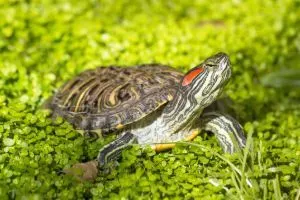
- Experience Level: Beginner
- Family: Emydidae
- Scientific Name: Trachemys Scripta Elegans
- Adult Size: Between 6 and 8 inches
- Lifespan: Between 20 and 40 years
- Average price range: Between $15 and $50
The Red-eared Slider is one of the most common types of pet turtle on the market. This semi-aquatic species has been sighted in northern and central counties in Maryland.
These turtles like to bask at the water’s edge, and often stack themselves on top of each other! Red-eared Sliders prefer warm, slow-moving waters. Their omnivorous diet consists of small fish, aquatic invertebrates, and underwater vegetation.
Red Eared Sliders commonly have an olive green shell bearing yellow striped markings on their scales. Their heads are usually a darker color, with yellow stripe markings and red patches just behind their eyes.
Check out our free red eared slider care guide for more on care.
16. Yellow Belly Slider

- Experience Level: Beginner
- Family: Emydidae
- Scientific Name: Trachemys scripta scripta
- Adult Size: Between 5 and 12 inches
- Lifespan: Between 20 and 40 years
- Average price range: Between $15 and $50
- Recommended books: Aquatic Turtles – Complete Herp Care by David T. Kirkpatrick
Yellow-bellied Sliders have recently been spotted in Maryland, but are not a native species. They are mainly found in rivers and lakes, and sometimes even in ditches filled with water.
As their name implies, these turtles have yellowish undersides as well as yellow bars and patches on their skin and shells. These markings also continue over their back legs. They often bask on the shore.
Yellow-bellied Sliders are active during the day and are omnivorous, mainly feeding on aquatic plants as well as invertebrates, mollusks, and small fish and tadpoles.
Sea Turtles In Maryland
Five species of sea turtles are also seen in the waters off the coast of Maryland. They are the Green sea turtle, Hawksbill sea turtle, Leatherback and Loggerhead turtles, and the Ridley’s or Kemp turtle. Of course, sea turtles cannot be kept as pets, but here are a few facts about each species.
17. Green Sea Turtle

- Family: Cheloniidae
- Scientific Name: Chelonia Mydas
- Adult Size: Between 3 and 4 feet
- Weight: Between 300 and 400 lbs
- Lifespan: Between 80 and 100 years
- Conservation Status: Endangered
- Habitat: Bays and shores along coastlines and open ocean waters, seen during summer months
- Clutch Size: Around 110 to 115 eggs, with 2 to 5 clutches per breeding season
- Food: Mostly herbivores, eating algae, sea grasses and seaweed
- Appearance: Smooth green to brown shells shaped like hearts, edged in yellow. Cream colored scaly skin with shades of green
Check out our page on Green Sea turtles for more information.
18. Hawksbill Sea Turtle

- Family: Cheloniidae
- Scientific Name: Eretmochelys Imbricata
- Adult Size: Between 30 and 35 inches
- Weight: Between 100 to 155 lbs
- Lifespan: Between 30 and 50 years
- Conservation Status: Critically Endangered
- Habitat: Shallow coastal areas of rocky or tropical waters, reefs and estuaries
- Clutch Size: Between 140 to 200 eggs, about 4 clutches per breeding season
- Food: Omnivores, mainly consuming crustaceans, mollusks, and algae
- Appearance: Prominent, beak-shaped mouths (like a hawk), oval shells in shades of amber with unique markings. Flippers also have claws at their “elbows”
For more information, check out our Hawksbill Sea turtle page.
19. Kemp’s Ridley Sea Turtle

- Family: Cheloniidae
- Scientific Name: Lepidochelys Kempii
- Adult Size: Around 25 inches
- Weight: Between 75 and 100 lbs
- Lifespan: Around 30 years
- Conservation Status: Critically Endangered
- Habitat: Sandy or muddy coastlines with shallow waters
- Clutch Size: Between 100 and 110 eggs, 2 to 3 clutches per breeding season
- Food: Crustaceans, shellfish
- Appearance: Slightly hooked beaks, triangle-shaped heads. Green to gray round shells. Muted cream or yellow plastrons and undersides.
Head to our Kemp’s Ridley sea turtle page for more information.
20. Leatherback Sea Turtle

- Family: Dermochelyidea
- Scientific Name: Dermochelys Coriacea
- Adult Size: Between 6 and 7 feet
- Weight: Between 1200 and 1450 lbs
- Lifespan: Around 30 years
- Conservation Status: Vulnerable
- Habitat: Warm waters, mainly shallow, calm bays or lagoons. Nests common on sandy beaches.
- Clutch Size: Between 100 and 110 eggs
- Food: Jellyfish is the staple of their diet, but they will also eat other sea creatures
- Appearance: Their large carapaces are soft, unique among sea turtles, with prominent ridges all the way down. Colors vary between black and a dark gray.
For more information, see our Leatherback sea turtle page.
21. Loggerhead Sea Turtle

- Family: Cheloniidae
- Scientific Name: Caretta caretta
- Adult Size: Between 30 and 45 inches
- Weight: Approximately 155 pounds
- Lifespan: Between 70 and 80 years
- Conservation Status: Endangered
- Habitat: Coastal regions, mainly shallow bays. Prefer sub-tropical waters. Sandy ocean beaches for nesting
- Clutch Size: Between 100 and 125 eggs, 4 to 5 clutches per breeding season
- Food: Carnivorous, mainly eating shellfish, mollusks, and crustaceans
- Appearance: Largest hard-shelled turtles with a reddish-brown carapace and large heads. Undersides are cream to yellowish. Long powerful flippers
Check out our Loggerhead sea turtle page for more information.
Conclusion
That covers the list of 13 native turtles of Maryland. This diverse range of species covers common turtles like the Snapping or Spotted turtles, to rarer or endangered species such as the Bog turtle, Common Map turtle, and Spiny Softshell turtles.
We’ve also covered 3 non-native species who have been spotted in Maryland, usually after being released from captivity. These are the False Map turtle as well as Red-eared and Yellow-bellied Sliders. Any sightings should be reported to wildlife authorities.
We have also looked at 5 species of sea turtles that have been seen in Maryland waters. All of these stunning turtles are sadly endangered, ranging from the well-known Green Sea turtles to the large Leatherback or Loggerhead turtles.
Did you enjoy this list? Then feel free to comment below and discuss these fascinating animals with other herp enthusiasts!
Other nearby states
- Turtles in Delaware
- Turtles in Europe
- Turtles in New Jersey
- Turtles in Pennsylvania
- Turtles in Virginia
- Turtles in West Virginia
